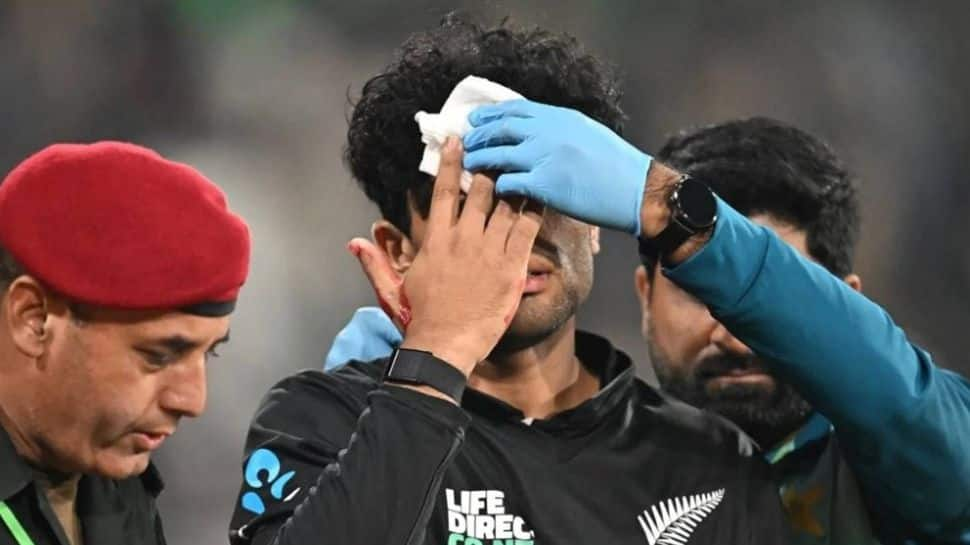 |
|
The first ODI between New Zealand and Pakistan at Lahore's Gaddafi Stadium was marred by an unfortunate incident involving New Zealand all-rounder Rachin Ravindra. During the 38th over, while attempting a catch at deep midwicket, Ravindra was struck on the forehead by the ball. The impact resulted in a significant laceration, forcing him to immediately leave the field for medical attention. While New Zealand Cricket (NZC) released a statement confirming the injury and assuring that Ravindra was recovering well after a head injury assessment (HIA), the incident has ignited a debate surrounding the adequacy of the stadium's floodlighting system.
Eyewitnesses, including commentators and players, have voiced concerns about inconsistent lighting at Gaddafi Stadium, suggesting it may have contributed to Ravindra's misjudgment of the ball. Reports indicate that some of the stadium's floodlights are outdated, leading to uneven illumination across the field. This isn't the first time such concerns have been raised; players have previously expressed apprehension about visibility issues under the lights at this historic venue. While there's no definitive proof linking the faulty lighting to Ravindra's injury, the incident raises crucial questions about the standard of stadium infrastructure in international cricket. Many modern venues have upgraded to LED lighting systems offering far superior consistency and brightness, leading to calls for similar improvements at Gaddafi Stadium. The Pakistan Cricket Board (PCB) will likely face increased pressure to address these concerns and ensure player safety is prioritized.
This injury adds to New Zealand's existing injury woes. Fast bowler Lockie Ferguson is already sidelined due to a hamstring injury sustained during the ILT20 tournament. Despite these setbacks, New Zealand demonstrated their depth and resilience, convincingly defeating Pakistan by 78 runs. New Zealand's innings was anchored by captain Kane Williamson's steady 58 and Daryl Mitchell's composed 81, but the highlight was an explosive century by Glenn Phillips (106* off 74 balls), propelling New Zealand to a challenging 330/6. Pakistan's chase began promisingly with Fakhar Zaman's rapid 84, but after losing key wickets, their middle order crumbled under pressure. Salman Agha and Tayyab Tahir offered some resistance, but Pakistan ultimately fell short, reaching 252 in 47.5 overs. New Zealand's disciplined bowling attack, led by Mitchell Santner (3/41), Matt Henry (3/53), and Michael Bracewell (2/41), restricted Pakistan's scoring and secured a comfortable victory. The match showcased New Zealand's ability to overcome adversity, but also underscored the pressing need for improved safety standards in international cricket venues.
The incident involving Rachin Ravindra highlights a wider issue within the sport: the importance of ensuring consistent and high-quality stadium infrastructure. While advancements in lighting technology offer significant improvements in visibility and player safety, many older stadiums still rely on outdated systems. This poses a risk not only to the players' physical well-being but also to the integrity of the game itself. Misjudgments caused by inadequate lighting can lead to injuries, unfair dismissals, and potentially even game-altering decisions. The investment in modern LED lighting systems should be considered not merely as a luxury but as a vital safety measure and an essential component of ensuring fair play. International cricket governing bodies should collaborate to establish minimum standards for stadium infrastructure, including lighting systems, to minimize risks and protect players.
The contrasting performances of New Zealand and Pakistan further emphasize the importance of strong squad depth and strategic planning. While Pakistan's batting faltered in the face of disciplined bowling and potentially challenging lighting conditions, New Zealand's ability to withstand injuries and still deliver a commanding victory showcased the strength of their squad. The incident with Ravindra and the prior injury to Ferguson served as a reminder of the unpredictable nature of professional sports, highlighting the need for teams to have capable replacements and strategies to cope with such setbacks. The long-term impact of Ravindra’s injury remains uncertain, but the incident serves as a wake-up call for the PCB and other cricket boards to prioritize player safety and invest in essential improvements to stadium infrastructure. This incident necessitates a thorough review of safety protocols and infrastructure across all international venues to mitigate similar risks in the future. The focus should shift from just winning matches to ensuring that the game is played in a safe and fair environment for all participants.
